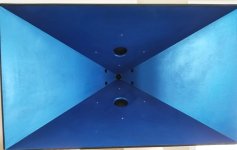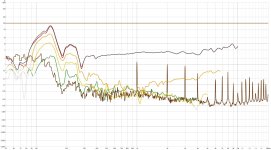Oouu - rush me to the burn unit ;-DSo room for massive maturing ;-)
//
English? are you gonna pretend to not see that huge resonant note at 2k?Why I'm I here rubbernecking again.... over and out.
How does my Horn have cleaner output at 115db than your waveguide does at 77db?!
I'm being dead serious...what is this.
Last edited:
My interest in the ESP plug got re-kindled after a person I know purchased a pair of Klipsch Jubilee (which uses Celestion Axi2050 with THE mysterious plug).
The Jubilees sound really good to be honest and are to be used for soul and disco parties.
Hopefully after Christmas I will be able to do polars and (hopefully) settle the klipsch plug argument.
The latest itteration of the ESP plug still has issues and this is how it measures on axis.
Blue Trace - Semi-OSSE horn (no plug)
Green Trace - Semi -OSSE horn with ESP plug (shifted 10db down)

And quick and dirty on axis vs. off axis vs. more off axis with 10db offsets
EQ'd "flat" on axis

And last graph with the traces with no offset and 1/6 Oct Smoothing
At this point I'm not sure if the ESP plug is screwing with the directivity or the horn itself is a bit off.

@aragorus! Thank you for sharing, Do you have more to show? RAW FR, THD, High level Measurements Etc!? I'm really looking for waterfall measurements. If you can get them please share them please
Last edited:
@camplo set your slices to something like 20 or 30, time-range to 3 ms, rise time to 0,1 ms and then start with the window at 0,5 ms.
Now slowly increase the window while watching that wave front build up. As soon as you start to see a sudden change in the frequency curve that's building up, that's when there is another signal messing with the direct output. You can try this with the measurement taken outside, if you want to check for diffraction.

Shown here is the unattainable ideal of a true Dirac pulse. If you flip trough Window size from 0,5 to about 7 ms, you should see the build up of the measured wave front, any sudden changes in shape of that wave front indicates energy that's added at that time interval. This way you can check when that change happens.
A zoomed in wavelet or spectogram could show something too, if you look in detail at the first, say 10 ms. You might see a parallel shape building up next to the wavefront that is shown at about the same time interval at which you noticed a change in window size.
Now slowly increase the window while watching that wave front build up. As soon as you start to see a sudden change in the frequency curve that's building up, that's when there is another signal messing with the direct output. You can try this with the measurement taken outside, if you want to check for diffraction.
Shown here is the unattainable ideal of a true Dirac pulse. If you flip trough Window size from 0,5 to about 7 ms, you should see the build up of the measured wave front, any sudden changes in shape of that wave front indicates energy that's added at that time interval. This way you can check when that change happens.
A zoomed in wavelet or spectogram could show something too, if you look in detail at the first, say 10 ms. You might see a parallel shape building up next to the wavefront that is shown at about the same time interval at which you noticed a change in window size.
"Bending ridges" are exactly what one should expect from diffraction. A resonance in the source itself will be a vertical ridge - effect is independent of angle. But if the secondary source is not at the same location as the primary one, then the ridges will curve as the interaction changes with angle.That particular graphs looks peculiar, the "ridges" bend from high frequency to low frequency with increasing angle, which is not common sight so not quite sure yet what could be the source
Camplo, just for something to look at, because it's not a good raw CD/horn alone, to compare to.
It's both full-range and processed...syn10 version on a PPSL sub, outdoors of a deck. No gating.
Uses bms4594 CD on a 90x60 straight-sided conical horn with no secondary flares. So about as bad of a mouth termination as it gets. Horn pict below.
Add 12dB for 4m measurement distance, so call it 105db 1m. Not up to the 115dB of yours, but using the same 30dB color range scale for the waterfall.


It's both full-range and processed...syn10 version on a PPSL sub, outdoors of a deck. No gating.
Uses bms4594 CD on a 90x60 straight-sided conical horn with no secondary flares. So about as bad of a mouth termination as it gets. Horn pict below.
Add 12dB for 4m measurement distance, so call it 105db 1m. Not up to the 115dB of yours, but using the same 30dB color range scale for the waterfall.

The polar response will not be the same at your preferred distance of 1m (the horn's near field) as it would be at 3m.OK guys, teach a man to fish
Lets say this is my Vertical polar at 3m... halve all the angles I guess... First, I noticed there is no issues at 200hz.... We've got some stuff going on around 1k, all off axis. Can someone explain in layman's terms why this is the straw the broke the camels back.
Not sure what you mean by "halve all the angles I guess", -6dB at 45 degrees off axis would be considered a 90 degree horn. Above 1kHz, a -10 dB drop in level sounds about half as loud.
There is nothing "backbreaking" about a beamy horn, it just limits the width or height of the listening field where the timbre, the relation of a fundamental frequency to it's harmonics remain the same.
When one moves off axis from a beamy horn, the lower frequencies remain the same level over a wide field, while the upper frequencies drop off more, like putting progressively thicker pillows between your ears and the source. That problem becomes worse the closer the listening distance- the perceived high frequency level can drop in half moving your head just a few inches.
Comparing these two polars, we can see that with the top one (Genelec 8381A) one could move their head twice as far as the lower one ("Lets say this is my Vertical polar at 3m") without gross changes in timbre.
If one wants to actually make decisions regarding the tonal balance of music, using the upper monitor would allow far more freedom of movement- you could stand up and walk around, or have someone share the larger area that provides a similar sonic "image".
"Bending ridges" are exactly what one should expect from diffraction. A resonance in the source itself will be a vertical ridge - effect is independent of angle. But if the secondary source is not at the same location as the primary one, then the ridges will curve as the interaction changes with angle.
Thanks. Always wondered how to interpret that information from the contour graphs.
Yes, add my thanks. Good info /explanation."Bending ridges" are exactly what one should expect from diffraction. A resonance in the source itself will be a vertical ridge - effect is independent of angle. But if the secondary source is not at the same location as the primary one, then the ridges will curve as the interaction changes with angle.
@camplo....you asked for the mdat for waterfall in #12,590
Here's a burst decay from it, to go along..
Attachments
Sifting through slowly. Above is a THD reading from inside the house. At 119db I can only imagine what wasn't shaking.View attachment 1246627
View attachment 1246628
If you are now happy with 18% third harmonic distortion at 233 Hz and below at 109 dB from 1 meter away, sure, you have enough headroom.
I can sing louder than that, but who cares...
I've attached the mdat file. This is outside on my deck, pointed at the sky. @weltersys IS this measurement is proof enough that there is enough headroom? It looks that way to me. In stereo, the channel will be down another 3db, From 300hz down Thd is under 5%, with the 200hz 48db XO, in this testing at 116db/1m. Any other details see the mdat file.Thd measurements are more accurate outside it seems. According to the above I have more than enough headroom to cross at 200hz, wouldn't you say?
I think this settles the THD debate.... any one disagree?
Attachments
Interesting, thank you for sharing.... What I am missing is measurements of something like a NS15 at 1m outside.... Or some other waveguide + compression driver combo that would be considered top notch.@camplo set your slices to something like 20 or 30, time-range to 3 ms, rise time to 0,1 ms and then start with the window at 0,5 ms.
Now slowly increase the window while watching that wave front build up. As soon as you start to see a sudden change in the frequency curve that's building up, that's when there is another signal messing with the direct output. You can try this with the measurement taken outside, if you want to check for diffraction.
The chart actually says 5% at 150hz.... is it wrong?
@weltersys comment was in regards to the 119db measurement inside of a living room. You need quietness to take thd, not a vibrating living room full of stuff. The last measurement is outside
@weltersys comment was in regards to the 119db measurement inside of a living room. You need quietness to take thd, not a vibrating living room full of stuff. The last measurement is outside
Last edited:
I never did measurements outside, so I doubt that any exist. But the gated ones are still posted on my website.What I am missing is measurements of something like a NS15 at 1m outside...
I don't think that in room measurements mean very much. That's because they include all reflections and our hearing just doesn't work that way. Better are anechoic measurements or gated and LF fitted ones as these show what the source is doing independent of the room. Adding in discussion of room acoustics to this thread will just make it even more confusing.
- Home
- Loudspeakers
- Multi-Way
- Is it possible to cover the whole spectrum, high SPL, low distortion with a 2-way?
